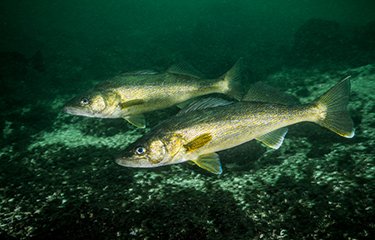Wisconsin-based scientists believe commercial farming of walleye, a favorite fish for Midwesterners in the U.S., could be closer to fruition.
According to a recent story in the Wisconsin State Journal, University of Wisconsin (UW) fish biologists and researchers at the Northern Aquaculture Demonstration Facility in Bayfield and the Aquaponics Innovation Center at Nelson & Pade in Montello are closing in on commercial aquaculture production of the Walleye, a freshwater fish also called Yellow Pike.
One UW professor told the newspaper that the fish can be raised in land-based recirculating aquaculture systems (RAS), and that they know the type of tanks and feed required to grow a one pound, 14-inch walleye in 12 months. He said one of the last remaining barriers for raising walleye commercially is to genetically modify the fish to produce eggs multiple times a year.
The potential to meet the demand for walleye production year-round is what makes farmed walleye a winner, observers said.
The buyers at Fortune Fish and Gourmet, the largest distributor of seafood in the Midwest, explained that the wild fishery for walleye tends to slow down in the hotter summer months as the fish goes out to cooler deeper waters in the Great Lakes. Fishermen tend to slow down production those months because of additional fuel and time costs.
“Fortune is a strong advocate for aquaculture if it’s done responsibly and sustainably,” Jon Rezny, the company’s vice president of purchasing, told SeafoodSource.
He explained that there is always a potential for any new species that is being farm raised, but there are some variables that would determine whether the farm raised version would be more desirable than the wild counterpart.
“The two biggest factors for most of our customers are price and taste,” Rezny said. “If the pricing on a farmed Walleye is close to the wild version and the flavor is similar, I expect the farmed Walleye to be successful. If the pricing on the farmed product is substantially more expensive or the flavor is not the same, then it might not have the same demand.”
Because wild walleye are limited in the summer, demand outweighs supply.
“A farmed Walleye with year-round production would help improve the shortages certain times of year,” he said.
However, the question remains, would a chef want to replace a wild Walleye on his menu with a farmed one?
“I think some would and some would just stick to the wild version,” he said.
Another trend that doesn’t bode well for the wild whitefish fishery is current demographics within the industry.
“There is one important trend that I am hearing about in the whitefish community,” explained Rezny. “Several of the Great Lakes whitefish ... fishermen have said that there is a lack of interest in commercial fishing from their younger generation. More and more of the fishermen’s sons and daughters are going into other businesses after graduating high school and/or college instead of going into the family fishing business. If this is also happening in the Walleye community than I would think the future could be bright for farmed Walleye.”
Photo courtesy of Shutterstock







